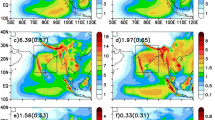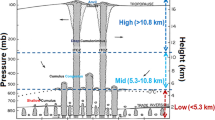Abstract
Earlier studies reported the contrasting cloud properties over central India during intraseasonal oscillation of the Indian summer monsoon (ISM). This intraseasonal ISM variation in the cloud vertical structure (VSC) over different parts of India is yet to be explored. To fill this gap area, VSC derived from nine years of CloudSat measurements over geographically different but having homogenous ISM rainfall Indian regions are selected for the study. We investigated VSC, types of clouds, and microphysical properties during the intra-seasonal variation of ISM. Significant contrast was found in the mid-tropospheric cloud region during the ISM spells. Analysis of cloud types shows significant intra-seasonal variability with the presence or absence of mixed-phase clouds (As, Ns, and Ac). In ISM (active and break) spells, the core monsoon regions (CI, CE, WI) share similar VSC features (complete or void mid-levels). Hence, microphysical properties follow similar characteristics except for ice water content which differs profusely among them. Over these regions, ten times higher ice effective radius during active days indicates dominating ice process compared to break days. Larger-sized ice hydrometeors (> 25 μm) are present at 5–6 km, which shows good interrelation with the ISM active and break spells above freezing level, and its size decreases with altitude. Whereas no difference in VSC is found during different ISM spells over the eastern part of India (WB and EI) except in the ice microphysical parameters, which are more dominant during break days. Further, irregular and discontinuous VSC over North and South India (NI and SI) could be due to their pertinent geographical conditions. Suppression of cloud processes at mid-tropospheric altitude is one of the most important reasons behind reduced precipitation over the core ISM regions. Mid-tropospheric drying is a remarkable sign of ISM break, which is the main source of suppressed convection and cloud activity over the core ISM region. This CloudSat study brought robust composite cloud vertical structure for the ISM intra-seasonal variability of cloud over different regions of India to improve the understanding of cloud-related processes and then increase the predictive capabilities of large-scale models.













Similar content being viewed by others
Data Availability
The CloudSat data used in this study is available at https://www.cloudsat.cira.colostate.edu/data-products. For the KaSPR data, please contact the corresponding author (kalapureddy1@gmail.com).
Abbreviations
- ISM:
-
Indian summer monsoon
- As:
-
Altostratus
- Ns:
-
Nimbostratus
- Ac:
-
Altocumulus
- CI:
-
Central India
- CE:
-
Central East India
- WI:
-
West India
- WB:
-
West Bengal
- EI:
-
East India
- NI:
-
North India
- NW:
-
North-West India
- SI:
-
South India
- WGs:
-
Western Ghats
- Cu:
-
Cumulus (including cumulus congestus)
- Sc:
-
Stratocumulus
- Ns:
-
Nimbostratus
- Ac:
-
Altocumulus
- As:
-
Altostratus
- St:
-
Stratus
- LWC:
-
Liquid water content
- IWC:
-
Ice water content
- IER:
-
Ice effective radius
- INC:
-
Ice number concentration
- CPR:
-
Cloud Profiling Radar
References
Austin RT, Heymsfield AJ, Stephens GL (2009) Retrieval of ice cloud microphysical parameters using the CloudSat millimetre wave radar and temperature. J Geophys Res Atmos 114:D8
Baker MB (1997) Cloud microphysics and climate. Science 276(5315):1072–1078
Das S, Maitra A, Shukla AK (2011) Melting layer characteristics at different climatic conditions in the indian region: ground based measurements and satellite observations. Atmos Res 101(1–2):78–83
Das SK, Uma KN, Konwar M, Raj PE, Deshpande SM, Kalapureddy MCR (2013) CloudSat–CALIPSO characterizations of cloud during the active and the break periods of indian summer monsoon. J Atmos Solar Terr Phys 97:106–114
Fujinami H, Yasunari T, Morimoto A (2014) Dynamics of distinct intraseasonal oscillation in summer monsoon rainfall over the Meghalaya–Bangladesh–western Myanmar region: covariability between the tropics and mid-latitudes. Clim Dyn 43(7–8):2147–2166
Gadgil S (2018) The monsoon system: land–sea breeze or the ITCZ? J Earth Syst Sci 127(1):5
Gadgil S, Sajani S (1998) Monsoon precipitation in the AMIP runs. Clim Dyn 14(9):659–689
Gambheer AV, Bhat GS (2001) Diurnal variation of deep cloud systems over the indian region using INSAT-1B pixel data. Meteorol Atmos Phys 78(3–4):215–225
Goswami BN, Mohan RA (2001) Intraseasonal oscillations and interannual variability of the indian summer monsoon. J Clim 14(6):1180–1198
Goswami BN, Xavier PK (2005) Dynamics of “internal” interannual variability of the indian summer monsoon in a GCM. J Geophys Res Atmos 110:D24
Houze RA, Wilton DC, Smull BF (2007) Monsoon convection in the himalayan region as seen by the TRMM Precipitation Radar. Q J R Meteorol Soc 133(627):1389–1411
Hunt KM, Fletcher JK (2019) The relationship between indian monsoon rainfall and low-pressure systems. Clim Dyn 53(3):1859–1871
Jiang X, Waliser DE, Li JL, Woods C (2011) Vertical cloud structures of the boreal summer intraseasonal variability based on CloudSat observations and ERA-interim reanalysis. Clim Dyn 36(11–12):2219–2232
Johansson E, Devasthale A, L’Ecuyer T, Ekman AM, Tjernström M (2015) The vertical structure of cloud radiative heating over the indian subcontinent during summer monsoon. Atmos Chem Phys 15(20):11557–11570
Johnson RH, Rickenbach TM, Rutledge SA, Ciesielski PE, Schubert WH (1999) Trimodal characteristics of tropical convection. J Clim 12(8):2397–2418
Joseph PV, Sijikumar S (2004) Intraseasonal variability of the low-level jet stream of the asian summer monsoon. J Clim 17(7):1449–1458
Kalapureddy MCR, Sukanya P, Das SK, Deshpande SM, Pandithurai G, Pazamany AL, Annam S (2018) A simple biota removal algorithm for 35 GHz cloud radar measurements. Atmos Meas Tech 11(3):1417–1436
Krishnamurti TN, Ardanuy P (1980) 10- to 20-day westward propagating mode and ‘‘Breaks in the Monsoons’’. Tellus 32:15–26
Krishnamurti TN, Bhalme HN (1976) Oscillations of a monsoon system. Part I. Observational aspects. J Atmos Sci 33(10):1937–1954
Krishnamurti TN, Thomas A, Simon A, Kumar V (2010) Desert air incursions, an overlooked aspect, for the dry spells of the indian summer monsoon. J Atmos Sci 67(10):3423–3441
Liu C, Zipser EJ, Mace GG, Benson S (2008) Implications of the differences between daytime and nighttime CloudSat observations over the tropics. J Geophys Res 113:D00A04. https://doi.org/10.1029/2008JD009783
Medina S, Houze RA Jr, Kumar A, Niyogi D (2010) Summer monsoon convection in the himalayan region: terrain and land cover effects. Q J R Meteorol Soc 136(648):593–616
Mooley DA, Shukla J (1989) Main features of the westward-moving low pressure systems which form over the indian region during the summer monsoon season and their relation to the monsoon rainfall. Mausam 40(2):137–152
Patade S, Shete S, Malap N, Kulkarni G, Prabha TV (2016) Observational and simulated cloud microphysical features of rain formation in the mixed phase clouds observed during CAIPEEX. Atmos Res 169:32–45
Qian Y, Long CN, Wang H, Comstock JM, McFarlane SA, Xie S (2012) Evaluation of cloud fraction and its radiative effect simulated by IPCC AR4 global models against ARM surface observations. Atmos Chem Phys 12(4):1785–1810
Rajeevan M, Gadgil S, Bhate J (2010) Active and break spells of the indian summer monsoon. J Earth Syst Sci 119(3):229–247
Rajeevan M, Rohini P, Kumar KN, Srinivasan J, Unnikrishnan CK (2013) A study of vertical cloud structure of the indian summer monsoon using CloudSat data. Clim Dyn 40(3–4):637–650
Rao TN, Uma KN, Satyanarayana TM, Rao DN (2009) Differences in draft core statistics from the wet to dry spell over Gadanki, India (13.5° N, 79.2° E). Mon Weather Rev 137(12):4293–4306
Rind D, Rossow WB (1984) The effects of physical processes on the Hadley circulation. J Atmos Sci 41(4):479–507
Sathiyamoorthy V, Pal PK, Joshi PC (2004) Influence of the upper-tropospheric wind shear upon cloud radiative forcing in the asian monsoon region. J Clim 17(14):2725–2735
Sato T, Kimura F (2007) How does the tibetan Plateau affect the transition of indian monsoon rainfall? Mon Weather Rev 135(5):2006–2015
Subrahmanyam KV, Kumar KK (2017) CloudSat observations of multi layered clouds across the globe. Clim Dyn 49:327–341. https://doi.org/10.1007/s00382-016-3345-7
Sukanya P, Kalapureddy MCR (2019) Cloud microphysical profile differences pertinent to monsoon phases: inferences from a cloud radar. Meteorol Atmos Phys 131(6):1723–1738
Sukanya P, Kalapureddy MCR (2021) Cloud radar observations of multi-scale variability of cloud vertical structure associated with indian summer monsoon over a tropical location. Clim Dyn 56(3):1055–1081
Wang J, Rossow WB (1998) Effects of cloud vertical structure on atmospheric circulation in the GISS GCM. J Clim 11(11):3010–3029
Wang B, Kang IS, Lee JY (2004) Ensemble simulations of asian–australian monsoon variability by 11 AGCMs. J Clim 17(4):803–818
Weare BC (2000) Insights into the importance of cloud vertical structure in climate. Geophys Res Lett 27(6):907–910
Webster PJ, Magana VO, Palmer TN, Shukla J, Tomas RA, Yanai MU, Yasunari T (1998) Monsoons: processes, predictability, and the prospects for prediction. J Geophys Res Oceans 103(C7):14451–14510
Yuter S, Houze R (1995) Three-dimensional kinematic and microphysical evolution of Florida Cumulonimbus. Part I: spatial distribution of Updrafts, downdrafts, and precipitation. Mon Weather Rev 123(7):1921–1940
Zhang J, Li Z, Chen H, Yoo H, Cribb M (2014) Cloud vertical distribution from radiosonde, remote sensing, and model simulations. Clim Dyn 43(3):1129–1140
Zuidema P (2003) Convective clouds over the Bay of Bengal. Mon Weather Rev 131(5):780–798
Deng J, Qiu Y, Chen Y, Yang L, He Q, Zhang P (2014) The vertical distribution of ice particle effective radius of clouds and its correlation with precipitation during heavy rainfalls. J Nat Disasters. 23:120–128. https://doi.org/10.13577/j.jnd.2014.0216
Goswami BN, Ajayamohan RS, Xavier PK, Sengupta D (2003) Clustering of synoptic activity by indian summer monsoon intraseasonal oscillations. Geophys Res Lett 30(8)
L’Ecuyer TS, Jiang JH (2011) Touring the atmosphere aboard the A-Train. In: AIP Conference Proceedings, vol 1401, no. 1, pp 245–256. AIP
Rajeevan M, Nanjundiah RS (2009) Coupled model simulations of twentieth century climate of the indian summer monsoon. In: Platinum Jubilee Special Volume of the Indian Academy of Sciences, 537–568
Rao YP (1976) Southwest Monsoon. In: Meteorological Monograph (Synoptic Meteorology), No.1/1976. India Meteorological Department, New Delhi, p 366
Sassen K, Wang Z (2008) Classifying clouds around the globe with the CloudSat radar: 1-year of results. Geophys Res Lette 35(4)
Sikka DR (1978) Some aspects of the life history, structure and movement of monsoon depressions. In: Monsoon dynamics. Birkhäuser, Basel, pp 1501–1529
Subrahmanyam KV, Kumar KK (2013) CloudSat observations of cloud-type distribution over the indian summer monsoon region. In: Annales Geophysicae, vol 31. Copernicus GmbH, p 1155. 7
Stephens GL, Vane DG, Tanelli S, Im E, Durden S, Rokey M, L’Ecuyer T (2008) CloudSat mission: performance and early science after the first year of operation. J Geophys Res Atmos 113(D8)
Webster PJ (1986) The elementary monsoon. In: Monsoons, 3. Monsoons, Wiley, New York, 1987, 3–32
Wood N (2008) Level 2B radar-visible optical depth cloud water content (2B-CWC-RVOD) process description document. Version 5 1-26
Zhang J, Chen H, Li Z, Fan X, Peng L, Yu Y, Cribb M (2010) Analysis of cloud layer structure in Shouxian, China using RS92 radiosonde aided by 95 GHz cloud radar. J Geophys Res Atmos 115(D7)
Acknowledgements
IITM is an autonomous organization that is fully funded by MOES, Govt. of India. The authors are thankful to the Director of IITM, for every support and help on this research work. The authors are highly indebted to Dr. Jeevanprakash R Kulkarni for his feedback on the initial draft, discussions, and encouragement. Mr. C. Ameya Manas helps in coding extensive data, and the suggested corrective measures are highly appreciated. We are equally grateful to the CloudSat team for data portal help.
Author information
Authors and Affiliations
Corresponding author
Additional information
Publisher’s Note
Springer Nature remains neutral with regard to jurisdictional claims in published maps and institutional affiliations.
Rights and permissions
Springer Nature or its licensor (e.g. a society or other partner) holds exclusive rights to this article under a publishing agreement with the author(s) or other rightsholder(s); author self-archiving of the accepted manuscript version of this article is solely governed by the terms of such publishing agreement and applicable law.
About this article
Cite this article
Kalapureddy, M.C.R., Patra, S., Dhavale, V. et al. CloudSat inferred contrasting monsoon intra-seasonal variation in the cloud vertical structure over Indian regions. Clim Dyn 61, 1567–1589 (2023). https://doi.org/10.1007/s00382-022-06643-0
Received:
Accepted:
Published:
Issue Date:
DOI: https://doi.org/10.1007/s00382-022-06643-0




